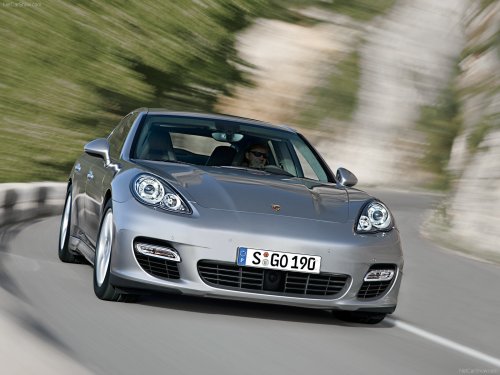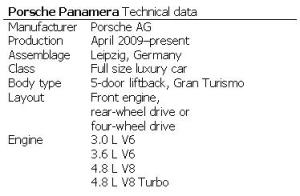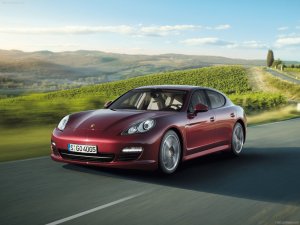- Porsche Panamera
- Luxury sedan with coupe profile


The Porsche Panamera (Type number 970) is a four-door, four-seat luxury sedan with a coupe profile and a rear hatch. It is front-engined with rear-wheel drive, with a four-wheel drive version also available.
The Porsche Panamera production model was unveiled at the 13th Auto Shanghai International Automobile Show in Shanghai, China, on April 2009.
Porsche Panamera Concept and description
The Porsche Panamera’s name is derived, like the Porsche Carrera line, from the Carrera Panamericana race. Earlier prototypes and concepts of the four-door saloons, such as the 1991 Porsche 989 prototype, the four-door Porsche 911 based prototype, and the C88 concept (a supermini sedan built in Germany and sold forChina), never went into production.
The Porsche Panamera is generally considered to be the long-awaited fruit of Porsche’s 989 concept from the late 1980s; some argue that it also presents itself as a successor to the two-door 928, but there may be plans to develop a new 928 as well.

The Porsche Panamera and Porsche Panamera S are marketed as a direct competitor to full-size luxury sedan such as the BMW 7 Series and Mercedes-Benz S-Class. The high performance Porsche Panamera Turbo competes in the ultra-luxury segment alongside “exotics” such as the Bentley Continental Flying Spur, Aston Martin Rapide, and Maserati Quattroporte, as well as the top-performing versions of flagship luxury sedans. Similar vehicles to the Panamera include the BMW 5 Series Gran Turismo and Mercedes-Benz CLS-Class.
Like the Porsche Cayenne SUV (which has become the marque’s best-selling vehicle), the Porsche Panamera upset many Porsche enthusiasts, since it was seen as an attempt to broaden Porsche’s appeal beyond that of hardcore fans. The Porsche Panamera ran contrary to the company’s signature offerings, particularly its light two-door rear-engine sports cars like the Porsche 911. The Porsche Panamera on the other hand is considered a full-size luxury car, weighing at nearly 4,000 pounds (1,800 kg), with four doors, and its V8 engine mounted in the front. The Panamera’s unusual appearance with its long hood and bulbous rear hatch bears little resemblance to a stretched 911, although it does resemble the Porsche 911 from certain angles. The iconic Porsche 911 has a sparse interior, as it was focused on raw performance, while the Porsche Panamera has a sumptuous interior loaded with modern technological amenity and expensive leather upholstery.
Porsche Panamera Production
Engines are first assembled in Stuttgart, and the car’s body is built and painted at the Volkswagen Group facility in Hannover. The final assembly of the vehicle takes place in Leipzig, Germany, alongside the Cayenne.
Porsche Panamera Production began in April 2009, one month after its debut in the Shanghai Motor Show in China. Porsche will keep production rate at around 20,000 cars per year.
Porsche has applied for patents on a four-door convertible version of the Porsche Panamera that keep the same general dimensions.
Porsche Panamera Specifications
The naturally aspirated versions of the Porsche Panamera have rear-wheel drive as standard, while the Porsche Panamera Turbo version includes standard four-wheel drive with Porsche Traction Management (PTM). A notable addition is the all-new ZF Friedrichshafen supplied and developed 7-speed 7DT-75 PDKdual clutch transmission.

The V8-powered Porsche Panamera S and Porsche Panamera 4S, and Panamera Turbo were the first trims that debuted. Porsche debuted two further models on February 16, 2010: the Porsche Panamera and Porsche Panamera 4 which are both powered by 3.6-litre V6 engines producing 300 horsepower. The Porsche Panamera and Panamera S are rear-wheel drive, while the Panamera 4 has the same four-wheel drive system as the Porsche Panamera 4S and Turbo. Being derived from the V8 engine of the Panamera S and Panamera 4S, the V6 retains the V8’s technologies like Direct Fuel Injection, infinitely-variable intake camshaft adjustment with variable valve lift (VarioCam Plus), an on-demand oil pump, water cooling with thermal management, a variable intake manifold, as well as integrated dry sump lubrication with two-stage extraction of oil and, and an Auto Start-Stop function (only with the PDK transmission).
The full lineup will include the Porsche Panamera base model, Panamera 4, Panamera S, Panamera 4S and Panamera Turbo; a hybrid variation, the Porsche Panamera S Hybrid, was unveiled in February 2011 and will join the model range in July of the same year.
Porsche Panamera Handling
The Porsche Panamera comes with the Porsche Traction Management (PTM), which is Porsche’s name for its fully-controlled, four-wheel drive system. PTM is standard on both the Porsche Panamera 4S and the Panamera Turbo. Optional Sports Chrono Packages include a Sport Plus button, which has tighter damping and air springs, and lowers the car body by 25 mm (1.0 in)
Hybrid variation

In 2008, Porsche AG announced the development of a parallel hybrid system for the Porsche Panamera. According to Car and Driver, it may use a 3.6 litre V6 engine with a 34 kilowatts (46 hp) electric motor found in the Cayenne hybrid.
In March 2011, Porsche unveiled the Panamera S Hybrid in Geneva Motor Show 2011. Using the same drivetrain seen in the Porsche Cayenne S Hybrid – an Audi-sourced supercharged 3.0L V6 engine producing 333 horsepower along with an electric motor rated at 47 horsepower, as well as the Porsche Cayenne’s eight-speed Tiptronic S transmission – the 380hp Panamera S Hybrid can accelerate from 0-100 km/h in 5.7 seconds. It would produce only 159 grams of carbon dioxide per kilometer, rendering it the cleanest car in the entire Porsche model range. The car is also the range’s most economical with respect to fuel consumption.
Porsche Panamera Reception
Despite the differences in dimensions and design, a reviewer noted that the Panamera’s driving dynamics were close to that of the Porsche 911, and it “seems to occupy the no-man’s-land between really good sports sedans and proper sports cars”, and so far the Porsche Panamera has won every comparison test against other four-door performance cars on the market such as the more expensive Maserati Quattroporte and Aston Martin Rapide. Function was also praised, with the 15.7 cubic feet hatchback trunk, and the four-corner adaptive air suspension that retained superior handling while also providing a comfortable ride for public roads.
The Porsche Panamera S weights 400 pounds (180 kg) less than the 2011 BMW 550i which is 4,376 pounds (1,985 kg)
